Eastern Communities
Jump to: Cumberland County Communities
Clark County
Marshall
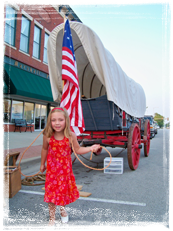 Platted in 1835, Marshall served as the welcome to Illinois for National Road travelers. The town was founded by Col. William B. Archer and Joseph Duncan, a future Illinois governor. The community was named for John Marshall, Chief Justice of the U.S. Supreme Court. Archer, along with founding Marshall, was Clark County’s first county clerk and circuit clerk. He served two years in the Illinois House of Representatives before two terms in the state senate. He was assigned the rank of Colonel during the Blackhawk War.
Platted in 1835, Marshall served as the welcome to Illinois for National Road travelers. The town was founded by Col. William B. Archer and Joseph Duncan, a future Illinois governor. The community was named for John Marshall, Chief Justice of the U.S. Supreme Court. Archer, along with founding Marshall, was Clark County’s first county clerk and circuit clerk. He served two years in the Illinois House of Representatives before two terms in the state senate. He was assigned the rank of Colonel during the Blackhawk War.
The influx of settlers to the community resulted in the county seat being moved there in 1838. An original stone arch bridge from the National Road era can be seen on the west side of town. Abraham Lincoln was a frequent visitor to Marshall during his circuit riding days and developed some lifelong friendships in the town.
Col. Archer was a member of the Illinois delegation to the 1856 Republican National Convention and addressed the group following Lincoln's nomination for vice-president on the William C. Fremont ticket. Archer said he had been acquainted with Lincoln for 30 years, describing him as "pure a patriot as ever lived." When Lincoln's toughness was questioned, Archer emphatically responded, "He's strong mentally---he's strong physically---he's strong every way." Lincoln lost the VP nod to New Jersey’s William L. Dayton.
From 1950-1964, Marshall was the site of the Handy Writers Colony, which nurtured the writing of several authors, including James Jones.
Whether you are a history buff or planning an event, Harlan Hall has something to offer for everyone. It is home to the National Road Welcome Center, Senior Diners' Club, and serves as a beautiful banquet hall for a variety of events, large and small. We invite you to explore the website and discover the fascinating history of Harlan Hall from its beginning in 1872 as a livery stable to where it is today.
During the week of June 22-26, 2016 over 150 artists from across the United States as well as Canada, New Zealand, Scotland, England and Australia descended upon Marshall leaving behind 16 historic murals and a custom glass piece. Known as the Walldogs, the loose affiliation of sign painters, graphic artists, and other talented individuals reunite annually to entertain and transform a community with their special brand of artistic interpretation, entertainment, and friendship.
The Marshall Chamber of Commerce had been working with Walldog Leader Scott Carl Lindley since 2012 to coordinate the meet, raise funds to support the project, and develop the themes that made Marshall's heritage come to life. Lindley assembled his team of project leaders to design and manage each mural topic. There are now over twenty-five murals in Marshall for visitors to enjoy.
Marshall has a National Road kiosk telling the history of Marshall which is located at the Welcome Center near the log cabin.
Martinsville
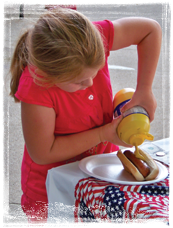 An Ohio native, Joseph Martin, purchased land in 1832 that he would plat a year later as the town he named for himself. With the construction of the National Road underway, the town’s early prosperity was directly related to the trail. Two men, Fitch and Redman, opened the first store which became the gathering place of the townspeople. Martinsville's economy has since relied on agriculture and oil. The Ohio Oil Company, a subsidiary of Standard Oil, operated a large tank farm west of Martinsville. According to an 1883 Clark County history book, Martinsville had a reputation for its horse-racing. In 1935 American thoroughbred horse racing trainer, Dale Baird, was born in Martinsville. At the time of his 2007 death, Baird had more wins, 9,445, than any other trainer in the sport's history.
An Ohio native, Joseph Martin, purchased land in 1832 that he would plat a year later as the town he named for himself. With the construction of the National Road underway, the town’s early prosperity was directly related to the trail. Two men, Fitch and Redman, opened the first store which became the gathering place of the townspeople. Martinsville's economy has since relied on agriculture and oil. The Ohio Oil Company, a subsidiary of Standard Oil, operated a large tank farm west of Martinsville. According to an 1883 Clark County history book, Martinsville had a reputation for its horse-racing. In 1935 American thoroughbred horse racing trainer, Dale Baird, was born in Martinsville. At the time of his 2007 death, Baird had more wins, 9,445, than any other trainer in the sport's history.
The former Odd Fellows Hall also served as a gymnasium and a ballroom / opera house on its third floor. Visitors will enjoy the Lincoln School, a one-room brick school built in 1880 and a museum since 1988. Martinsville is also home to the Rowe Foundry, a family owned business since 1898 that saw its origin in a blacksmith shop.
Martinsville officials are pursing the TRAIL project with a trail for bicyclists and hikers through Clark and Cumberland Counties. The group is securing land easements, construction firms, advertising entities, etc. to make the project successful. The eventual goal is to have the trail run from Clark County on the east to St. Clair County on the Mississippi River.
Martinsville has a National Road kiosk located in the city park.
Casey
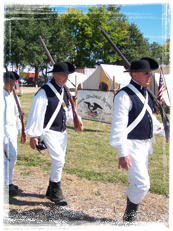 The origin of this town can be found in a settlement named Cumberland. A Post Office, named after Zadoc Casey, was established at Cumberland in 1838 but was discontinued nine years later. Cumberland is now part of the city of Casey. The original town was first platted in 1851 and surveyed in 1853. John Lang, a founding father, built the National House Hotel. The first store was started by John Cole.
The origin of this town can be found in a settlement named Cumberland. A Post Office, named after Zadoc Casey, was established at Cumberland in 1838 but was discontinued nine years later. Cumberland is now part of the city of Casey. The original town was first platted in 1851 and surveyed in 1853. John Lang, a founding father, built the National House Hotel. The first store was started by John Cole.
Casey was one of many towns along the National Road that grew thanks to the oil boom of the early 20th century. By 1907, around 2,000 oil wells had been drilled in the immediate Casey area. Casey’s Fairview Park was a spinoff of these prosperous years and at one time featured a racetrack. Visitors to Casey will observe a sign acknowledging native son, David Hanners, a 1989 Pulitzer Prize winning reporter.
The world's largest collection of the world's largest objects is in one small Illinois town- Casey, Illinois. The otherwise unassuming town of Casey is the home to an outsized number of the world’s largest things. The odd collection of giant objects includes a giant golf tee, wind chimes, knitting needles and crochet hooks, mailbox, birdcage, and rocking chair—all located near downtown. With chimes suspended 49 feet above the ground, the massive wind chime stands 55 feet tall and is a sight to behold. The longest of five chimes is 42 feet long—nearly double that of the previous world record holder. The chimes sing gentle and deep as they strike the clapper. On display across from the huge wind chime is the world’s largest rocking chair. This new chair, which was topped off on August 25, 2015, is 56 feet, 6 inches tall, and weighs 46,200 pounds. It beats the previous largest chair (42 feet, 1 inch tall) in Fanning, Missouri, which held the record for over seven years. A supremely impressive construction effort, a massive mailbox features a door that opens and closes by means of a cable winch. It’s across the street from a giant birdcage in which you can actually swing on the perch. The world’s largest golf tee, was placed behind the clubhouse at the Casey Country Club in 2013. The golf tee measures more than 30 feet from the ground to the top, with a head diameter of 6.26 feet and a shaft diameter of 2.1 feet, and is constructed with yellow pine boards held together by 60 gallons of glue and 120 pounds of screws. The total structure weighs 6,659 pounds. Things just keep getting bigger and bigger in Casey. One of the latest creations is a large pitchfork at Richard’s Farm Restaurant. At 60 feet long and weighing 1,940 pounds, this creation is one of the new items in Casey has in the Guinness Book of World Records. A recently built teeter totter stands across from the Casey Library. Other world’s largest items include wooden shoes, spinning top, bookworm outside the library, a giant gavel created for the Clark County Courthouse, ruler, and pencil.
Casey has a National Road kiosk located in front of city hall.
Cumberland County
Greenup
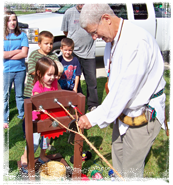 Located on the Embarras River, Greenup was named for William Greenup, supervisor of National Road construction in Illinois. Platted in 1834, the town's lifeline was the National Road which brought settlers and travelers. For several years, Greenup was the county seat. Abraham Lincoln was the defense attorney for an 1847 manslaughter case that was heard at the Cumberland County court in Greenup. Local legend claims that Lincoln, his father, and a cousin helped build the original covered bridge over the Embarras River. Another legendary visitor was Frank James who participated in the 1900 Cumberland County Fair as the honorary starter of the horse races.
Located on the Embarras River, Greenup was named for William Greenup, supervisor of National Road construction in Illinois. Platted in 1834, the town's lifeline was the National Road which brought settlers and travelers. For several years, Greenup was the county seat. Abraham Lincoln was the defense attorney for an 1847 manslaughter case that was heard at the Cumberland County court in Greenup. Local legend claims that Lincoln, his father, and a cousin helped build the original covered bridge over the Embarras River. Another legendary visitor was Frank James who participated in the 1900 Cumberland County Fair as the honorary starter of the horse races.
The town is nicknamed the "Village of the Porches" for its distinctive downtown architecture. A future military museum is housed in the former public library, a 1904 Carnegie funded project. Visitors will enjoy the local historical society museum and adjoining train museum, located in the original 1870 two-story depot. The community is also home of Quinn Broom Works, a family owned business since 1925.
Greenup has a National Road kiosk located near the Cumberland County Historical Society Museum on historic Route 40 through the center of town
Jewett
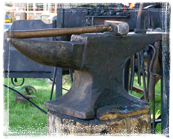 Founded in 1844 as Pleasantville, the town initially benefited from its location on the National Road. In its early years, the village had a mill, log church and was a stagecoach stop for the Terre Haute to St. Louis line. According to local lore, there was a "great stamping ground" near town where men engaged in friendly boxing matches. But, by 1870, Pleasantville was on the verge of disappearing. The arrival of the Vandalia Railroad line led to a resurgence and the renaming of the town to Jewett. At its peak, Jewett had several stores, churches, and a school.
Founded in 1844 as Pleasantville, the town initially benefited from its location on the National Road. In its early years, the village had a mill, log church and was a stagecoach stop for the Terre Haute to St. Louis line. According to local lore, there was a "great stamping ground" near town where men engaged in friendly boxing matches. But, by 1870, Pleasantville was on the verge of disappearing. The arrival of the Vandalia Railroad line led to a resurgence and the renaming of the town to Jewett. At its peak, Jewett had several stores, churches, and a school.



